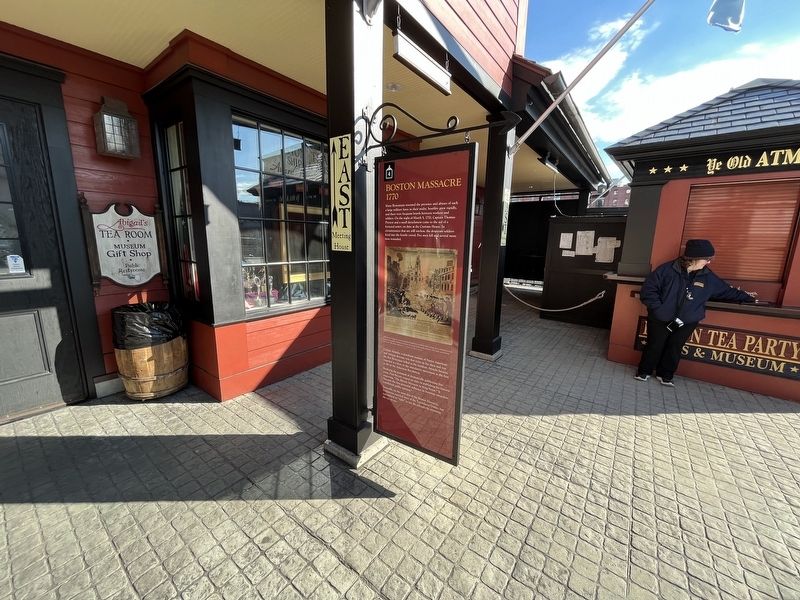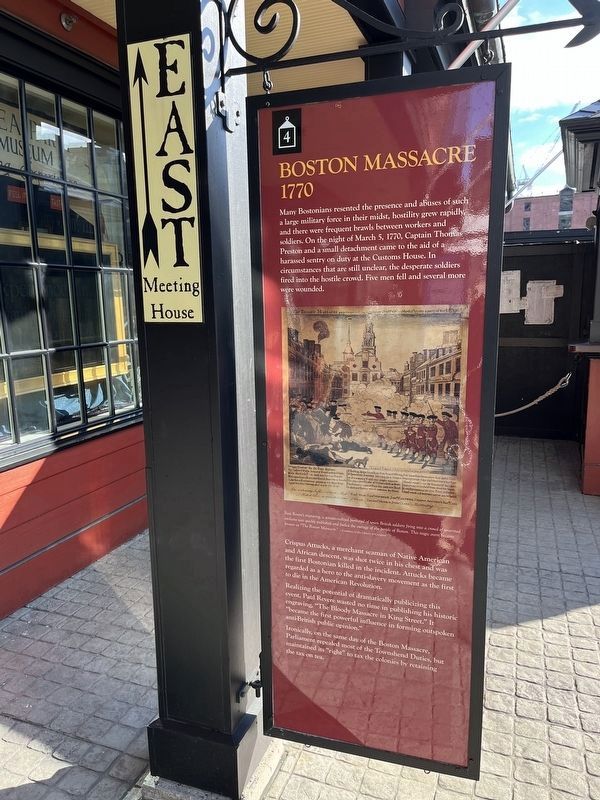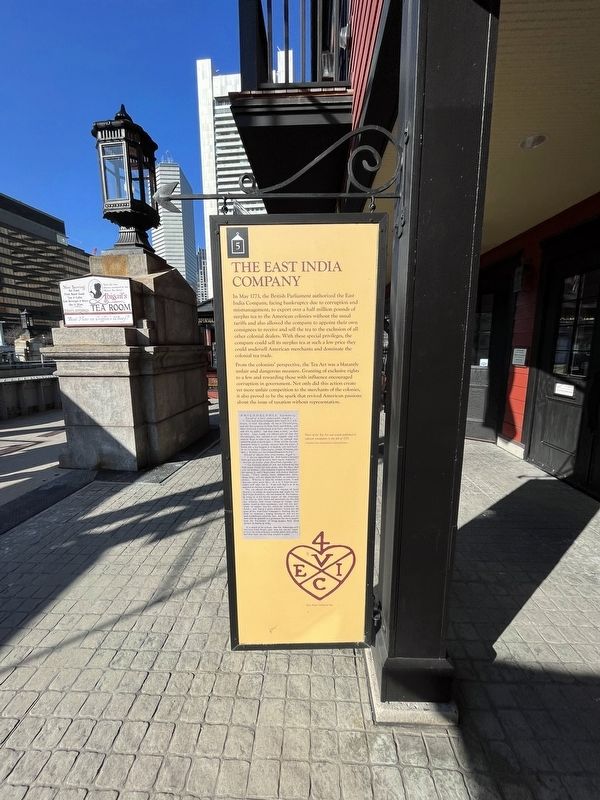D Street / West Broadway in Boston in Suffolk County, Massachusetts — The American Northeast (New England)
Boston Massacre 1770 / The East India Company
Boston Massacre 1770
Many Bostonians resented the presence and abuses of such a large military force in their midst, hostility grew rapidly, and there were frequent brawls between workers and soldiers. On the night of March 5, 1770, Captain Thomas Preston and a small detachment came to the aid of a harassed sentry on duty and the Customs House. In circumstances that are still unclear, the desperate soldiers fired into the hostile crowd. Five men fell and several more were wounded.
Crispus Attucks, a merchant seaman of Native American and African descent, was shot twice in his chest and was the first Bostonian killed in the incident. Attucks became regarded as a hero to the anti-slavery movement as the first to die in the American Revolution.
Realizing the potential of dramatically publicizing this event, Paul Revere wasted no time in publishing his historic engraving, "The Bloody Massacre in King Street." It "became the first powerful influence in forming outspoken anti-British public opinion."
Ironically, on the same day of the Boston Massacre, Parliament repealed most of the Townshend Duties, but maintained its "right" to tax the colonies by retaining the tax on tea.
[Caption:]
Paul Revere's engraving, a sensationalized portrayal of seven British soldiers firing into a crowd of unarmed civilians was quickly published and fueled the outrage of the people of Boston. This tragic event became known as "The Boston Massacre."
The East India Company
In May 1773, the British Parliament authorized the East India Company, facing bankruptcy due to corruption and mismanagement, to export over half a million pounds of surplus tea to the American colonies without the usual tariffs and also allowed the company to appoint their own consignees to receive and sell the tea to the exclusion of all other colonial dealers. With these special privileges, the company could sell its surplus tea at such a low price they could undersell American merchants and dominate the colonial tea trade.
From the colonists' perspective, the Tea Act was a blatantly unfair and dangerous measure. Granting of exclusive rights to a few and rewarding those with influence encouraged corruption in government. Not only did this action create yet more unfair competition to the merchants of the colonies, it also proved to be the spark that revived American passions about the issue of taxation without representation.
[Caption:]
News of the Tea Act was widely published in colonial newspapers in the fall of 1773.
Erected by Boston Tea Party Ships & Museum. (Marker
Topics. This historical marker is listed in these topic lists: Colonial Era • Government & Politics • Industry & Commerce • War, US Revolutionary. A significant historical date for this entry is March 5, 1770.
Location. 42° 21.126′ N, 71° 3.079′ W. Marker is in Boston, Massachusetts, in Suffolk County. It is in D Street / West Broadway. Marker is on Congress Street east of Dorchester Avenue, on the right when traveling west. Touch for map. Marker is at or near this postal address: 306 Congress St, Boston MA 02210, United States of America. Touch for directions.
Other nearby markers. At least 8 other markers are within walking distance of this marker. Old South Meeting House (here, next to this marker); Defending the Colonies 1763 (here, next to this marker); Stamp Act 1765 / Townshend Act 1767 (here, next to this marker); a different marker also named Old South Meeting House (a few steps from this marker); In Commemoration (within shouting distance of this marker); Building Boom (about 300 feet away, measured in a direct line); Entrepreneurial Spirit (about 300 feet away); The Great Fire (about 300 feet away). Touch for a list and map of all markers in Boston.

By Devry Becker Jones (CC0), January 28, 2023
3. Boston Massacre 1770 / The East India Company Marker
Credits. This page was last revised on February 3, 2023. It was originally submitted on February 3, 2023, by Devry Becker Jones of Washington, District of Columbia. This page has been viewed 161 times since then and 50 times this year. Photos: 1, 2, 3. submitted on February 3, 2023, by Devry Becker Jones of Washington, District of Columbia.

